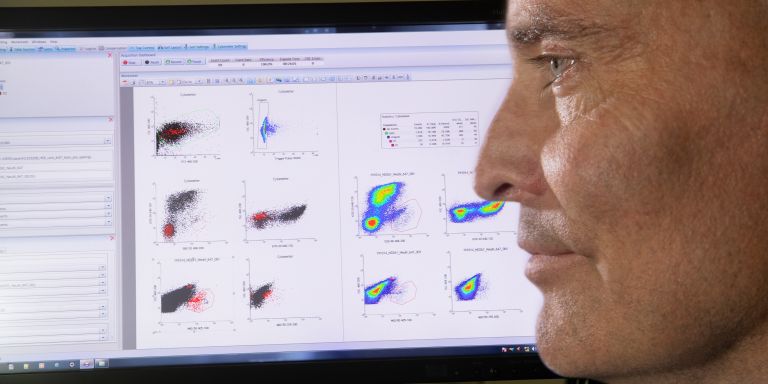
Jonas Frisén
Professor of Stem Cell Research
Wallenberg Scholar
Institution:
Karolinska Institutet
Research field:
Stem cell research, primarily on the heart and brain


Wallenberg Scholar
Institution:
Karolinska Institutet
Research field:
Stem cell research, primarily on the heart and brain
Freedom is the best thing you can have as a researcher, according to Jonas Frisén. It provides an opportunity to get to grips with really wild ideas that may lead to major breakthroughs. Now he is delving into an area that is little understood; the ageing of our bodies, and how far knowledge about stem cells can take us in our quest for eternal life.
His interest in stem cells was awakened looking down a microscope in 1993. He was studying tissue samples from two rats, one with a healthy spinal cord, the other with a spinal cord showing signs of disease. Something very unexpected was happening around the damaged spinal cord. New cells had begun to form, triggered by the damage. It was a revolutionary discovery.
“For a researcher, it was very much a classic ‘Eureka’ moment,” recalls Frisén, who is a professor at the Department of Cell and Molecular Biology at Karolinska Institutet.
Since then his research has always involved stem cells. His latest project is to map a family tree of the relationship between a stem cell and a mature cardiac muscle cell or brain cell (see article).
Frisén has been granted an extension to his Scholar grant by Knut and Alice Wallenberg Foundation, assuring funding for a total of ten years’ independent research.
“Long-term funding is obviously of great value. It allows the researcher to delve deeper, and try out more daring strategies. When it works, it really works,” he says.
…As with the idea of using the atmospheric concentration of carbon-14 to determine the age of cells. It was a real long shot that turned out to be right on target, thanks to a grant from the Foundation (see earlier article).
The researchers attracted great interest when they used the carbon-14 method to demonstrate that new cells form constantly in the human brain and heart. This contention had previously been highly controversial. New cells are formed to the same extent in the human brain as in mice, but some of them are formed in a quite different place.
Mice display vigorous regeneration of neurons in parts of the brain that process smells, among other things. This has no counterpart in humans. Human neuron regeneration instead takes place in the part of the brain called the striatum, which has changed dramatically during human evolution.
“This is where our motor functions are controlled, for example. Disruption of communication with the striatum impairs movement. This can be seen in people suffering from diseases such as Parkinson’s.”
The striatum also plays a major role in higher cognitive and intellectual functions, and plays a part in controlling our emotions.
“Dependency and reward systems are also located in the striatum, and these are plastic and adaptable. There may well be a good reason for neuron regeneration, since it lends a more malleable, plastic function to the brain.
Basic research differs greatly from clinical drug trials. Here, the work is curiosity-driven, and many research projects start with the seemingly simple question: “how does it work?”
“But in the end there is always a follow-up question: what happens when it doesn’t work, and can we do something about it?”
Thanks to the long-term funding the research team has received, they will be able to pursue more lines of inquiry than many other researchers. One of them concerns multiple sclerosis (MS). The researchers published their findings in Nature in 2019, revealing major differences between humans and animals in progress of the disease. Mice regenerate a specific type of supporting cell capable of slowing the disease. There is no such regeneration in humans. This underlines the importance of treating MS sufferers early to slow the disease.
“These findings emphasize the importance of further work on basic characterization of human diseases. We are probably more different from other mammals than we thought.”
When the research team used the immune system as a model for developing a new method, a new question arose. In what order are the various cells in the immune system formed, and could this have a bearing on the development of new vaccines?
“It’s true that we are working on many things at the same time, but this is positive because it creates synergies between different fields. It’s also more fun – and having fun is pretty important.”
Curiosity is a key driver. But, somewhat unexpectedly, so is the question of eternal life. Is it possible to prolong life using our knowledge of stem cells?
“Developing methods for regenerating cells in the brain and heart is a way of treating diseases that currently kill large numbers of people. Ageing itself has been little studied, which is actually quite surprising, given that it is such a universal issue,” Frisén says.
“Knut and Alice Wallenberg Foundation has been enormously important to my research team. Thanks to the Foundation, we have been able to carry out work that demands long-term commitment, with high risks.”
Jonas Frisén is one of our most well-respected and cited researchers. But he shies away from any mention of him as a “future Nobel candidate”.
“It’s nothing more than empty flattery, and actually quite unfortunate for me personally. I want to be seen as a blank sheet of paper when I meet new people – not as a symbol. And it’s not even true. Sure, I’ve been fairly successful, but not remarkably so,” he says.
Text Magnus Trogen Pahlén
Translation Maxwell Arding
Photo Magnus Bergström